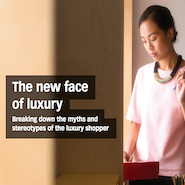- About
- Subscribe Now
- New York,
December 31, 2014

When it comes to luxury products, 73 percent of luxury consumers consider quality to be the most important attribute, according to a study by the Luxury Institute and Epsilon.
The report focuses on defining the different tiers of luxury consumers, focusing on those who are true luxe customers and those who are aspiring to that level. By understanding their consumers, luxury brands will be able to adjust their marketing tactics based on the individual’s level of consumption.
"The only way you can have a good understanding of a human being is to have honest dialogue with them," said Milton Pedraza, CEO of Luxury Institute, New York.
"You have to treat people as an individual and you have to have an honest and open dialogue with them," he said.
"The new face of luxury: Breaking down the myths and stereotypes of the luxury shopper" aims to better understand the luxury shopper. The research study was conducted by Epsilon in partnership with the Luxury Institute.
Deeper understanding
Interacting with consumers in a relevant and personal manner is key for brands looking to make a connection, especially since 50 percent of luxury brands lose their top clients every year. Also, since 47 percent of consumers say it is the customer service that defines a luxury brand, understanding and catering to the top customers is vital.
The study breaks down the luxury consumers into four categories: aspirational shopper, moments of wealth, dressed for the part and true luxe.
An aspirational shopper is that individual who wants to own luxury items, but cannot afford to on a regular basis. They typically shop at outlet stores or on discount Web sites and purchase low-ticket designer brand items.
Those categorized in the moments of wealth section of luxury shoppers may save for a specific piece from a specific luxury brand, but they are not a regular consumer of the brand.
Understanding luxe consumer
Dressed for the part shoppers purchase luxury items to present themselves as someone living a luxurious lifestyle, but do not have the finances to be true luxe shoppers.
True luxe shoppers do not have any financial concerns when purchasing and buy from luxury brands on a frequent basis.
Understanding where individuals lay in the scheme of luxury shopping and where they may jump to is important for brands. With a degree or a job change, consumers can move up a level of luxury shopping.
True luxe shoppers are statistically male and between the ages of 25 and 44. Fifty-two percent of them are single and 42 percent are college graduates. They are worth more than $500,000 and have annual incomes between $125,000 and $250,000.
Online shopping is less than 25 percent of sales for luxury brands, since consumers are still shopping in-person, leaving an opportunity for brands to offer more traditional white glove experiences.
However, this does not mean that luxe consumers are not actively online. Ninety-eight percent regularly use the Internet and more than 50 percent research products before purchasing. Also, 75 percent compare prices on their mobile devices.
Seventy percent of these consumers are on social media, but less than 25 percent engage with brands on Facebook. The digital nature of these consumers allows brands to have an online presence and attract consumers online, but offer customer service in-person.
The report suggests that brands organize and analyze housefile information to best understand their consumer’s habits and purchasing history.
Big data for personal results
Luxury brands are delving into more bespoke options and marketing, according to Wealth-X’s president at Luxury Retail Summit: Holiday Focus 2014.
Mr. Friedman spoke about the necessity among brands to understand their consumer, who they are, what they do and who their friends and family are in order to gain a full understanding of these individuals in order to effectively market. Luxury brands can learn from Wealth-X’s research on the ultra-high-net-worth individuals to create specific marketing strategy for the ultra-affluent (see story).
Some brands are adopting data trackers to attempt to understand in-store sales and trends.
For instance, Italian lingerie maker La Perla has teamed with a software platform to create a platform that will be implemented for all La Perla boutiques and fashion stores where its products are sold.
La Perla worked with MicroStrategy Mobile to analyze sales and other company data points through key performance indicators. This new technology will allow La Perla to be aware of information in all its stores and make necessary alterations to tactics without too much delay (see story).
Taking these opportunities to learn about and understand clients is vital for brands looking to engage and maintain a relationship with individuals.
"I think from the targeted marketing perspective if they understand who their clients are deeply they can really target those individuals and make it personal," Mr. Pedraza said.
"People will be excited about the human approach," he said. "It gives you a wonderful opportunity to connect with [them] in a truly unique and personal way."
Final Take
Nancy Buckley, editorial assistant on Luxury Daily, New York
Share your thoughts. Click here